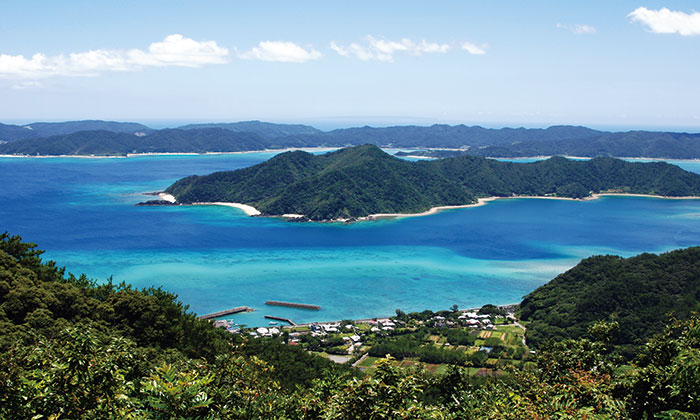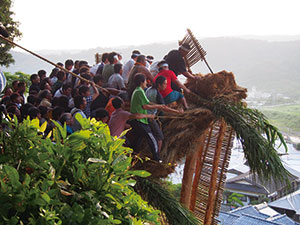- MOE
- National Parks of Japan
- Amamigunto National Park
- Characteristics
main body

Characteristics
Thriving nature in the subtropical islands
The forest, the ocean, and the life of the islanders
The forest, the ocean, and the life of the islanders
Date of Designation: March 7, 2017
Area: 42,181 ha (land area)
Related Prefecture: Kagoshima
Area: 42,181 ha (land area)
Related Prefecture: Kagoshima
Amamigunto National Park, a group of islands located in the southernmost part of Kagoshima Prefecture, was established as Japan's 34th national park on March 7, 2017.
The Amami Islands are a thriving ecosystem made up of a diverse array of natural environments and are the habitat of many rare, endemic plant and animal species. Furthermore, a distinctive cultural landscape, which developed from the long relationship between the islanders and nature, can still be found across the islands today.
At Amamigunto National Park, you can experience both the unique natural wonders on each island, as well as the history and culture of a place where humans and nature have long led an interwoven existence.
The Amami Islands are a thriving ecosystem made up of a diverse array of natural environments and are the habitat of many rare, endemic plant and animal species. Furthermore, a distinctive cultural landscape, which developed from the long relationship between the islanders and nature, can still be found across the islands today.
At Amamigunto National Park, you can experience both the unique natural wonders on each island, as well as the history and culture of a place where humans and nature have long led an interwoven existence.
Terrain/ Scenery

Mountain stream of AmamiOshima Island
History
The Amami Islands are located in the center of the arc-shaped archipelago of the Ryukyu chain. Due to intense shifts in the earth's crust starting from the Neogene Period of the Cenozoic Era (23 million to 2.6 million years ago), the islands were repeatedly connected to and separated from neighboring landmasses and the main island of Japan.

By approx. 12 million years ago
By around 12 million years ago, the archipelago was connected to the neighboring landmass. It is believed that many animals, including the ancestor of Amami Rabbit (Pentalagus furnessi), crossed over to the islands during this time.

Approx. 12 million to 2 million years ago
By around two million years ago, the Ryukyu chain had been separated into three larger island blocks: the Northern Ryukyus connected to Kyushu, the Central Ryukyus, and the Southern Ryukyus. During this time, the Amami area, where Amamigunto National Park is located, was part of the Central Ryukyu island.

Approx. 2 million years ago to present day
Afterwards, due to changes in sea level, Central Ryukyu was repeatedly separated from and connected to its neighboring islands, finally forming the Ryukyu chain of the present day. Through this process, many of the plants and animals inhabiting the area became trapped on the newly formed islands and over the next hundreds of thousands of years, they evolved into new species endemic to these islands themselves.
The islands can be divided into two types, depending on the way they were formed. Each island type differs greatly in the kinds of plants, animals, and landscapes that can be found there.

High, mountainous islands
(Kakeromajima)
High, mountainous islands
(Amami-Oshima, Kakeromajima, Ukejima, Yorojima, and Tokunoshima Islands)
These islands are composed of geological formations that were formed before the Neogene Period of the Cenozoic Era, and characterized by mountainous regions and great changes in elevation. The mountainous areas run up to the edge of the coastlines forming extremely steep cliffs and leaving little room for flatter ground.
(Amami-Oshima, Kakeromajima, Ukejima, Yorojima, and Tokunoshima Islands)

Low, flat islands
(Okinoerabujima)
Low, flat islands
(Kikaijima, Okinoerabujima, and Yoronjima Islands)
Formed during the Quaternary Period of the Cenozoic Era from Ryukyu limestone, these islands are low and flat with few mountainous areas. With the terraced terrain that developed during this period, you can find natural terraced hills made up of several "steps" much like a staircase on these islands.
(Kikaijima, Okinoerabujima, and Yoronjima Islands)
The Amami Islands have a warm, moist climate with an average annual temperature of 21°C and an abundant amount of annual precipitation (approximately 2,800 mm on Amami-Oshima Island). Owing to the differences in how each island was formed, the archipelago has a wonderfully diverse natural environment with subtropical, evergreen broad-leaved forests; tidal flats, a type of coastal wetland; zigzagging ria coasts, and coral reefs.
Plants
The woodlands of the Amami Islands are largely made up of subtropical evergreen, broad-leaved forests, with most dominant species being the evergreen beeches, including Castanopsis sieboldii, Quercus glauca var. amamiana, and Quercus miyagii.
The Amami Islands have a rich diversity of plant species comprised of a mixture of northern, temperate region species and southern, subtropical species. One of the particular characteristics of the Amami Islands environment is that it acts as the northernmost limit of habitat distribution for as many as 120 species of subtropical plants. Many endemic species, such as Lilium alexandrae of the lily family, Calanthe tokunoshimensis of the orchid family, and Rhododendron latoucheae var. amamiense of the rhododendron family, inhabit the islands, as well.

Calanthe tokunoshimensis of the orchid family
Wildlife
The Amami Islands also boast a high diversity of animal life including several endemic species and subspecies such as the Amami rabbit, Amami spiny rat, Tokunoshima spiny rat, Amami thrush, Kuroiwa's ground gecko, Ryukyu ayu (Plecoglossus altivelis ryukyuensis, a type of fish), and the Aegista kiusiuensis oshimana species of snail. Furthermore, a particularly unique ecosystem has developed on the islands of Tokunoshima and Amami-Oshima where a kind of venomous snake known as the habu viper sits at the top of the food chain.
The coastal areas serve as an important stopover and breeding area for many migrating animal species, and here you can find sea turtle spawning grounds and the breeding grounds for seabird colonies of terns and petrels.
In the sea, numerous kinds of fish, shellfish, and crustaceans inhabit a highly biodiverse coral reef comprised of around 220 confirmed species of reef-building coral. This reef is located at the northernmost limit in the world where a coral reef can develop to such a large area and high level of biodiversity.

Pentalagus furnessi
(the Amami rabbit)

Diplothrix legata
(Ryukyu long-tailed giant rat)

Zoothera dauma major
(the Amami thrush)

Goniurosaurus splendens
(Kuroiwa's ground gecko)

Amami Isikawa's frog

Black-naped tern

Oshimake snail
Culture

Shochogama
With historical influences from the Ryukyu Kingdom and the Satsuma domain, a colorful traditional culture developed on the Amami Islands characterized by various indigenous performing arts, religious traditions, and a unique view of nature. Examples of just some of the islands' local cultural customs include shimauta folk music; hachigatsu odori (a folk dance performed during August of the lunar calendar), and the Honensai harvest festival.

Shodon Sibaya
Due to these converging cultural influences, the region became a melting pot of the Ryukyu Kingdom culture of the south and the Yamato culture of the north where you can still see evidence of the mixed cultures in the local songs and performances.

Coral walls
Daily life in the past on the Amami Islands took place not only in the centrally situated villages, but also in the ocean and the forested mountains. The gods were believed to exist in both the seas and the mountains and everyday life itself became one with the natural environment. Up to this very day, the cultural landscape--the old roads, coral walls, and other traces of life in the past--still tell us stories of islanders' relationship with nature.
